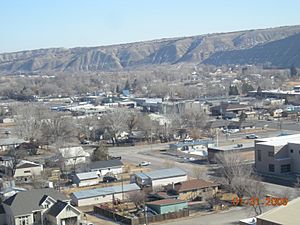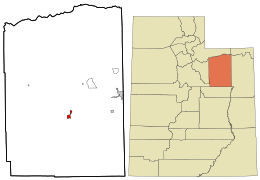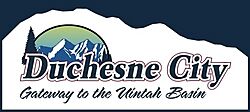Duchesne, Utah facts for kids
Quick facts for kids
Duchesne, Utah
|
||
|---|---|---|
|
City
|
||

Looking SouthEast and down on Duchesne, January 2009
|
||
|
||
| Nickname(s):
Forshame
|
||
| Motto(s):
Gateway to the Uinta Basin
|
||

Location in Duchesne County and the state of Utah
|
||
| Country | United States | |
| State | Utah | |
| County | Duchesne | |
| Settled | 1905 | |
| Named for | Duchesne River | |
| Government | ||
| • Type | Strong Mayor-Council | |
| Area | ||
| • Total | 2.80 sq mi (7.26 km2) | |
| • Land | 2.80 sq mi (7.26 km2) | |
| • Water | 0.00 sq mi (0.00 km2) | |
| Elevation | 5,712 ft (1,741 m) | |
| Population
(2020)
|
||
| • Total | 1,588 | |
| • Density | 600/sq mi (230/km2) | |
| Time zone | UTC−7 (Mountain (MST)) | |
| • Summer (DST) | UTC−6 (MDT) | |
| ZIP code |
84021
|
|
| Area code | 435 | |
| FIPS code | 49-20340 | |
| GNIS feature ID | 2410365 | |
Duchesne (pronounced doo-SHAYN) is a city in Utah, United States. It is the main city, or county seat, of Duchesne County. In 2020, about 1,588 people lived there.
Contents
History of Duchesne
Early Explorers and Trappers
In 1776, the Dominguez–Escalante Expedition explored the area. They found good land for farming and plenty of water.
Later, from 1822 to 1840, French Canadian trappers like Étienne Provost came to the Uintah Basin. They trapped many beavers and traded with the Uintah tribe. The Duchesne River, and later the city, got its name from these French Canadian trappers.
Settling the Land
Around 1900, people started arranging to use the land for sheep. The Ute tribe had a winter village where Duchesne is now. They were worried the sheep would eat all the good grass.
In 1905, the U.S. government set aside land for towns. Duchesne was one of these places. People could enter "land lotteries" to claim land. About 60 people settled in the area, calling it "Elsie" at first.
The first cabin was built in October 1905. A large tent served as a trading post and post office. The town's name changed a few times, first to "Dora," then to "Theodore" after President Theodore Roosevelt.
Challenges and Growth
The first winter was very hard. Many people lived in tents. In spring, the Duchesne River flooded the town every year until 1910. People had to move their homes to higher ground.
In 1907, local groups like the Boosters Club worked to improve the town. They built a bridge across the Strawberry River in 1908. The town grew quickly after the flooding problems were fixed.
By 1910, the population was 929. The town's first newspaper, The Duchesne Record, started in 1909. The citizens decided to change the name to "Duchesne." This change became official in 1911. Duchesne became an official city in 1913, and A. M. Murdock was its first mayor.
In 1914, Duchesne County was created, and Duchesne became the county seat (the main city for the county government). The name "Duchesne" likely comes from the river, possibly named after Mother Rose Philippine Duchesne.
Geography and Climate
Where Duchesne Is Located
Duchesne is in northeastern Utah, in the Uintah Basin. It sits near where the Strawberry River and Duchesne River meet. These rivers flow into the Green River further east.
Along the rivers, you can see cottonwood trees and willows. In other areas, you'll find sagebrush. Farmers in the area mostly grow Alfalfa.
Duchesne is about 114 miles west of Salt Lake City. It covers an area of about 2.8 square miles, all land.
Weather in Duchesne
Duchesne has cold winters with freezing temperatures. Summers are warm, sometimes hot. It doesn't get much rain, usually less than 10 inches a year. The wettest months are late summer to early fall. Winters are usually dry, but any precipitation that falls is snow.
Lua error in Module:Weather_box/colors at line 354: Unknown color scheme option.
Things to Do in Duchesne
Parks and Fun Places
Duchesne has many places for fun and activities:
- A public library.
- A swimming pool.
- A skate park.
- Two community parks with slides, swings, picnic tables, a football field, and baseball fields.
- A boardwalk along the Strawberry River with nice views.
- A seasonal ice skating pond behind the library.
- The Duchesne County Fair Grounds, which has a covered rodeo arena.
- The Duchesne County Centennial Event Center, a large indoor arena for events.
Outdoor Adventures
- Fred Hayes State Park at Starvation: This park is just west of Duchesne. It has Starvation Reservoir, a great lake for fishing and boating. You can catch rainbow trout, smallmouth bass, and walleye here. The reservoir has boat ramps, campsites, and showers.
- High Uintas Wilderness: About 30 miles north, this area is perfect for camping, hiking, and fishing.
- Hunting: Duchesne is known for its excellent big game hunting. You might see Mule deer, pronghorn antelope, elk, and moose nearby.
Getting Around Duchesne
Duchesne is located where several main roads meet: U.S. Route 40, U.S. Route 191, and State Route 87. Part of US-191 is called the Indian Canyon National Scenic Byway, which is a beautiful drive.
The Duchesne Municipal Airport is just northeast of town. It has a long runway for planes. There are plans to build a new railroad line, called the Uinta Basin Rail project, to help transport oil from the area.
Interesting Places to Visit
- Grave of William Long: Some research suggests that William Long, also known as the famous "Sundance Kid," might be buried in the Duchesne City cemetery.
- Pope Museum: This museum shows what life was like for early settlers. It has miniature vehicles that look just like the ones used long ago.
- Theodore Cemetery: This old pioneer cemetery was used from 1906 to 1914. It has a monument with the names of 41 early settlers.
- Father Escalante Monument: A monument honoring the early explorer Father Escalante.
- Early Duchesne Settlement Monument: Marks the spot of the first settlement.
- War Memorials: Monuments honoring soldiers from World War I, World War II, the Korean War, the Vietnam War, and Desert Storm.
- Saint Rose Philippine Duchesne Monument: A monument near the Pope Museum.
Schools in Duchesne
Duchesne is part of the Duchesne County School District. The schools serve Duchesne City and nearby communities like Bridgeland and Fruitland.
- Duchesne Elementary School: Serves students from kindergarten to 6th grade.
- Duchesne High School: Serves students from 7th to 12th grade. The first school building was built in 1907. The current high school was built in 2004–2005 and has two gyms, labs, and shops. Students can even take college classes there.
The high school mascot is the Eagle, and the colors are blue and white. Duchesne High has sports teams like football, basketball, wrestling, volleyball, track and field, and cross country. They have won many state championships in different sports.
Churches in Duchesne
There are three main churches in Duchesne:
- The Church of Jesus Christ of Latter-day Saints has two chapels and a seminary building.
- The First Baptist Church.
- The Catholic Church has a small mission office.
Jobs and Economy
Oil and Water Resources
Oil was discovered in the Uintah Basin in 1948. The oil industry creates jobs in Duchesne when oil prices are high. However, transporting the oil is difficult because it's very waxy. Most of it is moved by trucks.
Duchesne also benefits from its rivers. The Central Utah Project, a big water project, provided many jobs in the area from 1967 to 1987. The water treatment plant now supplies drinking water to other communities.
Manufacturing and Agriculture
Duchesne is home to companies that make heavy machines and steel. They create many products and parts for different industries, like oil fields, steel mills, and power plants. These products are shipped all over the world.
Farming has always been important to Duchesne. Ranchers use the land to graze cattle and sheep. While large-scale production has changed, small family farms are still a big part of the community.
Tourism
Duchesne's beautiful scenery attracts many tourists. People come to enjoy boating on Starvation Reservoir, fishing in the Strawberry and Duchesne rivers, and camping in the High Uintas.
Population Changes Over Time
| Historical population | |||
|---|---|---|---|
| Census | Pop. | %± | |
| 1910 | 929 | — | |
| 1920 | 700 | −24.7% | |
| 1930 | 590 | −15.7% | |
| 1940 | 907 | 53.7% | |
| 1950 | 804 | −11.4% | |
| 1960 | 770 | −4.2% | |
| 1970 | 1,094 | 42.1% | |
| 1980 | 1,677 | 53.3% | |
| 1990 | 1,308 | −22.0% | |
| 2000 | 1,408 | 7.6% | |
| 2010 | 1,690 | 20.0% | |
| 2019 (est.) | 1,710 | 1.2% | |
| U.S. Decennial Census | |||
Who Lives in Duchesne
In 2010, there were 1,690 people living in Duchesne. Most people were White (98.01%). About 2.57% of the population was Hispanic or Latino.
Many households (44.67%) had children under 18. The average household had about 3 people. The median age in the city was 28 years old.
The median income for a family in Duchesne was about $58,009.
Ancestry Groups (2015)
Here are some of the largest ancestry groups reported in Duchesne in 2015:
| Largest ancestries (2015) | Percent |
|---|---|
| English |
36.4% |
| German |
20.4% |
| Irish |
12.2% |
| Swedish |
7.3% |
| Scottish |
5.9% |
| Danish |
5.9% |
| Italian |
5.2% |
| American |
4.5% |
| Dutch |
2.3% |
| Norwegian |
2.2% |
| Welsh |
2.0% |
| French |
1.5% |
| Swiss |
2.0% |
See also
 In Spanish: Duchesne (Utah) para niños
In Spanish: Duchesne (Utah) para niños


